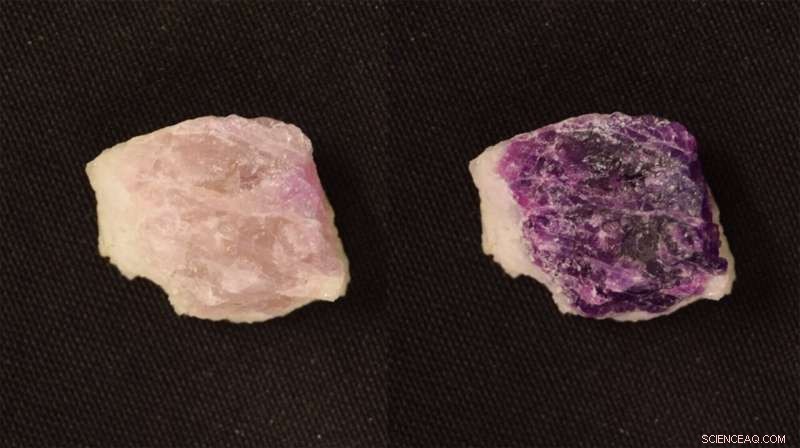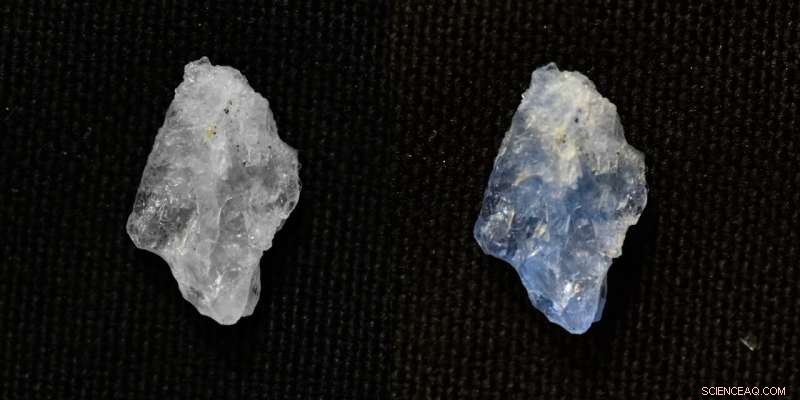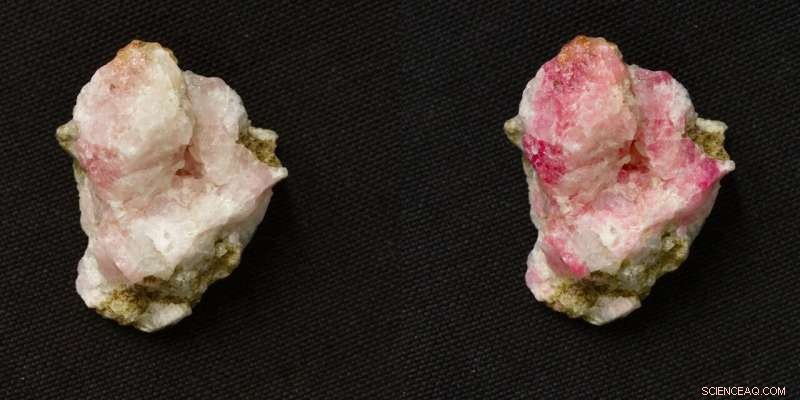
Hackmanit blir lila under UV-bestrålning, och färgen bleknar tillbaka till vit på några minuter under vanligt vitt ljus. Detta prov är från Grönland. Kredit:Mika Lastusaari
Under undersökningen av hackmanit fann forskare att det kan ändra färg vid exponering för UV-strålning upprepade gånger utan att slitas ut. Resultaten visar att den billiga hackmaniten, som är lätt att syntetisera, också har hög hållbarhet och flera applikationer.
En forskargrupp vid Åbo universitet, Finland, har undersökt och utvecklat hackmanitens egenskaper i nästan ett decennium. Tillämpningar som personlig UV-övervakning och röntgenbild har utvecklats baserat på hackmanites förmåga att ändra färg.
Hackmanite ändrar sin färg från vit till lila under UV-bestrålning och återgår så småningom tillbaka till vit om ingen UV är närvarande. De strukturella egenskaperna som möjliggör sådana upprepade förändringar har hittills varit oklara. Nu, efter att ha undersökt tre naturliga mineraler – hackmanit, tugtupit och skapolit – har forskarna hittat svaret.
Dessa färgskiftande mineraler är oorganiska naturmaterial, men det finns också organiska föreningar, kolväten, som kan ändra färg reversibelt på grund av exponering för strålning. Dessa kolväten kan dock bara ändra färg några gånger innan deras molekylära struktur bryts ner. Detta beror på att färgförändringen innebär en drastisk förändring i strukturen, och att genomgå denna förändring upprepade gånger bryter så småningom molekylen.
"I den här forskningen fick vi för första gången reda på att det faktiskt också finns en strukturell förändring inblandad i färgbytesprocessen. När färgen ändras, rör sig natriumatomer i strukturen relativt långt bort från sina vanliga platser och återvänder sedan. tillbaka. Detta kan kallas "strukturell andning", och det förstör inte strukturen även om det upprepas ett stort antal gånger", rapporterar professor Mika Lastusaari från Kemiska institutionen vid Åbo universitet, Finland.

Vit scapolite blir blå under UV-bestrålning. Färgningen och återgången till vitt efter att UV-källan tagits bort tar bara några sekunder, eftersom atomer i strukturen rör sig korta avstånd. Scapolite är ett ganska vanligt mineral. Detta prov är från Afghanistan. Kredit:Sami Vuori
Forskare bevisade att hackmanites förmåga att växla mellan vita och lila former är mycket repeterbar
Enligt professor Lastusaari beror hållbarheten på den starka tredimensionella burliknande övergripande strukturen hos dessa mineral, som liknar den som finns i zeoliter. I tvättmedel, till exempel, gör den burliknande strukturen det möjligt för zeolit att ta bort magnesium och kalcium från vatten genom att binda dem tätt inuti burens porer.
"In these color-changing minerals, all processes associated with the color change occur inside the pores of the zeolitic cage where the sodium and chlorine atoms reside. That is, the cage-like structure allows atomic movement inside the cage while keeping the cage itself intact. This is why minerals can change color and revert back to their original color practically indefinitely," Doctoral Researcher Sami Vuori explains.
Previously, it has been known that scapolite changes color much faster than hackmanite, whereas tugtupite's changes are much slower.
"Based on the results of this work, we found out that the speed of the color change correlates with the distance that the sodium atoms move. These observations are important for future material development, because now we know what is required from the host structure to allow the control and tailoring of the color change properties," says Doctoral Researcher Hannah Byron.
"There were no characterization methods available for the research on color changing minerals, which is why we have developed new methods by ourselves. However, it is difficult to interpret the results unambiguously based on experimental data alone. In fact, we could not have reached the present conclusions without strong support from theoretical calculations, since only the combination of experimental and computational data shows the whole picture. We owe a great many thanks to our collaborator Professor Tangui Le Bahers and his group, who have developed and advanced suitable computational methods to such detail and accuracy that would not have been possible just a few years ago," says Lastusaari.

Tugtupite is a rare mineral, which turns pink when exposed to UV radiation. The return back to white takes several hours, because it requires large atomic movements. This sample is from Greenland. Credit:Sami Vuori
Hackmanite has amazing potential for applications
The Intelligent Materials Research Group at the Department of Chemistry of the University of Turku, led by Lastusaari, has long conducted pioneering research on materials with light and color-related properties, especially on hackmanite. They are currently exploring numerous applications for hackmanite, such as possibly replacing LEDs and other light bulbs with the natural mineral and using it in X-ray imaging.
One of the most interesting avenues that the researchers are currently exploring is a hackmanite-based dosimeter and passive detectors for the International Space Station, intended to be used to measure the radiation dose uptake of materials during space flights.
"The strength of hackmanite's color depends on how much UV radiation it is exposed to, which means that the material can be used, for example, to determine the UV index of Sun's radiation. The hackmanite that will be tested on the space station will be used in a similar fashion, but this property can also be used in everyday applications. We have for example already developed a mobile phone application for measuring UV radiation that can be used by anyone," explains Sami Vuori.
The paper was published in June in the PNAS journal. + Utforska vidare